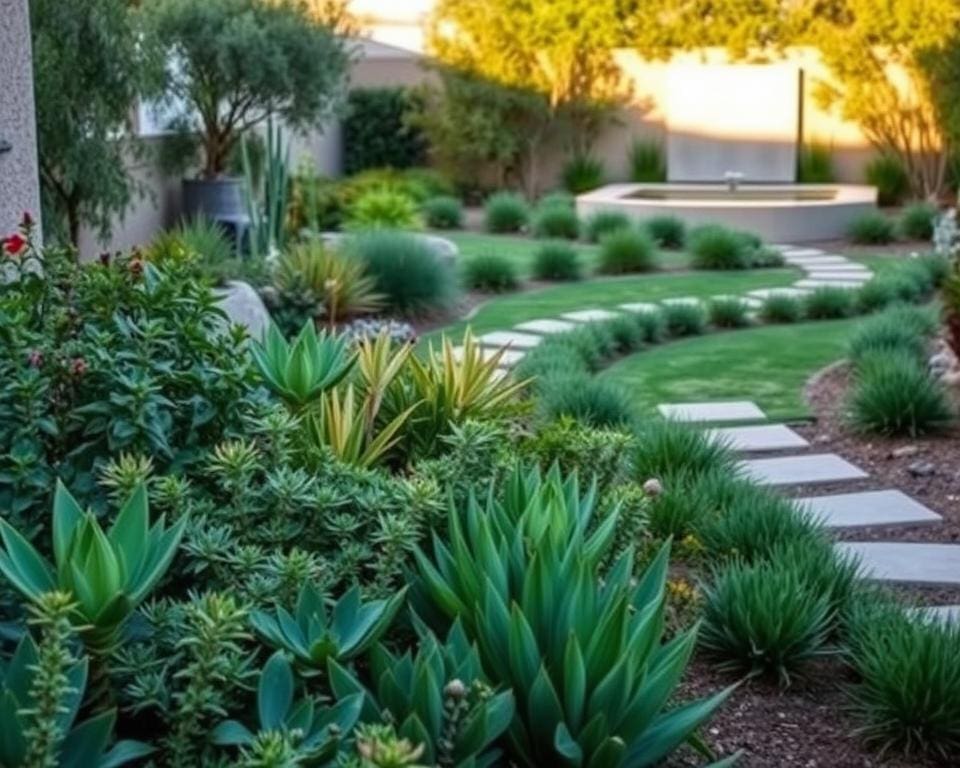Creating a low-maintenance backyard can truly transform your outdoor space into a sanctuary of relaxation. With the right approach, you can cultivate an easy-care outdoor space that allows you to enjoy the beauty of nature without the burden of excessive upkeep. This article offers practical backyard tips tailored specifically for the UK climate, helping busy homeowners achieve a serene garden that fits seamlessly into their hectic lifestyles. Discover how even the simplest designs and plant choices can lead to a more enjoyable and manageable garden experience.
Understanding the Concept of a Low-Maintenance Backyard
Creating a low-maintenance backyard means designing a space that not only captivates the eye but also reduces the demands of upkeep. This type of garden design embraces features that require minimal effort while still offering stunning aesthetics. Essential to this concept is the selection of easy-care plants, which thrive under local conditions and require less attention than traditional garden varieties.
Key characteristics of a low-maintenance garden include the integration of hardy plants that are well-suited to your climate. By focusing on native species and drought-resistant varieties, homeowners can significantly cut down on watering and fertilising, leading to a more sustainable garden environment. Furthermore, thoughtful garden design can foster efficient layouts that maximise natural light and reduce high-maintenance areas.
Utilising durable materials in your landscaping can also greatly affect the maintenance level of your backyard. Features such as gravel paths, stone walls, and composite decking not only look appealing but resist wear and tear over time. By aligning plant choices with the surrounding environment and using lasting construction, maintaining a low-maintenance garden becomes a simpler endeavour.

Choosing the Right Plants for Easy Care
Selecting the right plants for a low-maintenance garden can make all the difference. Native UK plants are an excellent choice, as they flourish in local soil conditions and require little attention. This not only conserves water but also reduces the need for fertilisers. Think of incorporating plants like lavender, which adds vibrant colour and pleasant fragrance, or wild geranium, known for its resilience and beauty.
Native Plants for Low Maintenance
Choosing native plants for your garden supports local ecosystems while providing a stunning display. These low-maintenance flowers thrive effortlessly, offering sustainability and charm. By planting native varieties, you create a lush landscape that attracts pollinators without the constant upkeep.
Choosing Drought-Resistant Varieties
It’s essential to consider drought-resistant plants, especially in a changing climate. These varieties notably withstand dry spells without frequent watering. Sedum and echinacea are perfect examples of robust options that not only endure but also bring visual appeal to your garden. Establishing these plants in well-drained soil and ensuring proper spacing helps optimise their growth and minimises maintenance needs.
Creating a Minimalist Design
A minimalist garden design embodies simplicity and functionality, making it an excellent choice for those seeking a low-maintenance backyard. By prioritising open spaces over cluttered areas, homeowners can significantly reduce the time spent on upkeep while enhancing the overall aesthetic appeal of their outdoor environment.
Open Spaces versus Cluttered Areas
Open spaces in a garden layout foster an environment that feels expansive and welcoming. These areas not only invite relaxation but also simplify maintenance tasks. In contrast, cluttered areas often result in overgrown plants and obstructed walkways, which call for regular attention. Adopting a minimalist approach allows for fewer, purposefully selected plants. This strategy leads to a garden that is both manageable and visually striking.
Incorporating elements that serve dual purposes can further contribute to a minimalist garden design. For instance, consider benches that offer hidden storage for tools or cushions. Creating focal points through strategic plant placements can draw the eye while highlighting the beauty of open spaces. This balance promotes a serene setting that embraces tranquillity and ease of care.
Top tips for a low-maintenance backyard
Transforming your garden into a low-maintenance oasis begins with incorporating effective hardscaping ideas that enhance both functionality and aesthetics. By utilising non-plant materials, you can minimise the need for constant upkeep while creating beautiful spaces to enjoy. The following tips demonstrate how to leverage hardscaping and functional garden design to achieve a stunning outdoor environment.
Utilising Hardscaping to Reduce Vegetation
Hardscaping serves as a powerful tool in the quest for a low-maintenance backyard. By integrating elements such as stone pathways, gravel areas, and patios, you can drastically decrease the amount of vegetation that requires mowing and weeding. These surfaces not only add visual appeal but also create durable spaces for entertaining or relaxation.
Incorporating Functional Elements
Incorporating functional garden design elements into your backyard enhances usability while cutting down on maintenance efforts. Built-in seating around a fire pit, decorative stone features, and raised vegetable beds serve practical purposes and create inviting spots for friends and family. Strategically placed benches offer rest areas, encouraging more time spent outdoors and less time on garden chores.
Efficient Watering Techniques
Implementing efficient watering techniques is essential for maintaining a low-maintenance backyard. Finding methods that support plant health while conserving water resources makes gardening both sustainable and practical. Two prominent techniques stand out: drip irrigation systems and rainwater harvesting.
The Benefits of Drip Irrigation
Drip irrigation systems provide a remarkable solution for those seeking efficient watering. These systems deliver water directly to the root zones of plants, reducing water evaporation and runoff. This targeted approach can lead to significant water savings and help prevent fungal diseases due to reduced moisture on plant surfaces. Adjustments can be made to ensure each plant receives exactly what it needs without excess, fostering healthy growth with minimal effort.
Rainwater Harvesting Solutions
Rainwater harvesting presents another excellent strategy for sustainable gardening. By collecting and storing rainwater, homeowners can create a viable source for watering plants throughout drier periods. This practice not only promotes efficient watering but also contributes to environmental sustainability. Utilizing collected rainwater reduces dependency on municipal water supplies and supports the ecosystem by decreasing stormwater runoff. Incorporating gutters and barrels into the backyard design can enhance this strategy, making it easy to manage and beneficial for both plants and the environment.
Choosing the Right Materials for Your Backyard
Creating a low-maintenance backyard starts with selecting the right materials. By opting for quality outdoor materials, you can achieve a space that requires minimal upkeep while remaining aesthetically pleasing. Focus on paving materials and fencing options that enhance the functionality of your garden without the hassle of constant care.
Low-Maintenance Paving Options
When considering paving materials, permeable pavers and decorative gravel stand out for their ability to facilitate drainage without excessive maintenance. These options not only promote water management but can also transform your outdoor area into a stylish sanctuary. Their durability makes them ideal for various weather conditions, ensuring your outdoor spaces remain pristine year-round.
Durable Fencing Ideas
Low-maintenance fences, such as composite wood and metal fencing, offer long-lasting solutions that require little attention over time. Composite materials provide the look of wood with added resilience against the elements, while metal fencing brings strength and sophistication. Proper installation of these fences ensures longevity and reduces the likelihood of future maintenance issues, allowing you to enjoy your outdoor space worry-free.
Incorporating Mulch for Soil Health
Using garden mulch plays a pivotal role in enhancing soil health and simplifying garden maintenance. It not only conserves moisture but also contributes to an overall healthier growing environment for various plants. Understanding the different types of mulch available can help you optimise your gardening efforts.
Types of Mulch for Different Areas
Choosing the right type of mulch is essential for achieving the desired effects in your garden. Various options cater to specific needs:
- Organic mulches, such as bark, straw, or wood chips, decompose over time, enriching the soil with essential nutrients.
- Inorganic mulches, like pebbles or landscape fabric, provide long-lasting solutions that suppress weeds without adding organic matter.
- Rubber mulch effectively reduces weed growth and retains moisture, making it suitable for playgrounds or pathways.
Benefits of Mulching for Plant Health
The benefits of mulching extend far beyond aesthetics. Effective use of garden mulch can dramatically improve plant health.
- Mulch helps maintain soil health by regulating temperature, creating a stable environment for roots.
- It significantly reduces weed growth, minimising competition for nutrients and water.
- Moisture retention provided by mulch can reduce the need for frequent watering, aiding in water conservation efforts.
- Nutrient enrichment from decomposing organic mulch encourages robust plant growth and enhances flowering and fruiting.
Managing Weeds Effectively
Integrating effective weed management into your gardening routine can significantly ease maintenance while promoting a healthier garden environment. Key strategies focus on prevention and natural solutions, ensuring a more sustainable approach to minimising unwanted growth.
Preventive Measures to Minimise Growth
Incorporating preventive measures is foundational for sustaining a low-maintenance garden. Consider the following prevention tips:
- Utilising ground cover plants that naturally suppress weeds.
- Ensuring proper spacing between plants to reduce competition for nutrients.
- Applying mulch to create a barrier that restricts light, hinders seed germination, and promotes soil health.
Natural Weed Control Solutions
When weeds do arise, natural weed control offers an environmentally friendly alternative to chemical herbicides. Some effective strategies include:
- Using vinegar sprays that target weeds without harming desirable plants.
- Implementing regular manual weeding to remove offenders before they spread.
- Embracing mulching techniques to maintain soil moisture while deterring weed growth.
Timing and Scheduling for Maintenance
A well-structured garden maintenance schedule is essential for keeping a low-maintenance backyard in optimal condition with minimal effort. Establishing a calendar that incorporates seasonal tasks will not only help you stay organised but also ensure your garden flourishes throughout the year. Whether it’s scheduling periodic pruning in spring or checking your irrigation system as summer approaches, having a clear plan allows you to manage your time efficiently while enjoying the beauty of your outdoor space.
The timing for care becomes even more important when considering the unique needs of your garden as the seasons change. As plants grow actively in spring and summer, engage in timely actions that promote health and vitality, such as mulching to retain moisture. Incorporating these seasonal tasks into your maintenance schedule can prevent overwhelming clean-up sessions and ensure a continually appealing landscape.
To streamline your efforts further, consider investing in time-saving tools such as automatic timers for irrigation systems. This will allow for consistent watering without the constant need for oversight. By embracing a balanced approach to garden maintenance, you can enjoy a flourishing outdoor space while minimising effort and maximising satisfaction.









